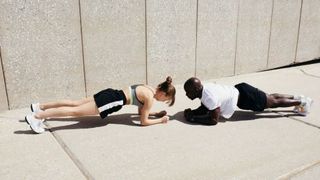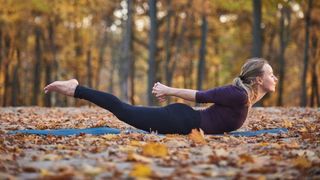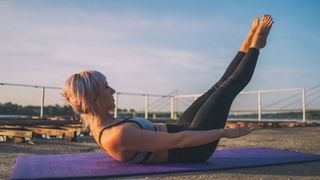Running Exercises For Beginners
Add these low-impact moves into your weekly routine to improve your running

Whether you’re a new runner or a veteran, strength and conditioning work should be a key part of your routine. For new runners in particular, it will help you strengthen key areas so your body can deal with the demands of the sport.
It’s important to tailor your workouts to running, though, because certain strength and mobility moves will be far more effective than others in helping you excel on the run. If you’re not sure what to do, start with these six exercises picked out by Dr Martin Yelling, a Garmin running ambassador, which can help you run faster, longer and reduce your risk of injury
The exercises have been chosen from a series of workouts on the Garmin Connect app, which you can follow on your wrist if you have a compatible Garmin tracker. Or just download the app, sign up for free and follow the instructions.
And don’t delay – try them today. “These strength and mobility exercises shouldn’t just be for when you’re feeling the onset of injury, discomfort or niggles,” says Yelling. “Rather, they should be used as a regular long-term preventative strategy that complements your running. When done frequently and properly, and incorporated into a structured plan in an appropriate way, the habit can get you running stronger, faster and further.”
Burpees
“Burpees are a great strength and conditioning activity to work the large muscles of the legs – your glutes and hamstrings – and your core and chest,” says Yelling.
“Stand with your feet shoulder-width apart and your hands at your sides. Quickly lower your hips and place your hands in front of your feet, then kick your feet back into a press-up position. Complete a press-up and then jump your feet back under your hips, then jump up and touch your hands behind your head. Repeat at a steady pace, starting off at a low intensity to focus on technique and control.”
Plank
“The plank is a simple exercise focusing on stability and strength for your abs and glutes,” says Yelling. “With your elbows directly beneath your shoulders and legs extended, lie on the floor and raise your torso. Ensure your body makes a straight line from your shoulders to your ankles. Hold this position, tightening your stomach and squeezing your glutes. To maximise stability, press your elbows into the floor.”
Get the Coach Newsletter
Sign up for workout ideas, training advice, reviews of the latest gear and more.
Locust pose

“The locust pose focuses on flexibility, mobility, breathing and strength,” says Yelling. “Lie face-down on a mat with your big toes together. Clasp your hands behind your sacrum [just above your tailbone] and use a big inhale to lift your chest and feet off the ground. Hold for three full breaths.
“Many runners are primarily chest breathers, using the upper part of their lungs and secondary breathing muscles. With this exercise, runners can shift their breathing, focusing on the smooth relationship between the diaphragm and pelvic floor. Not only does this exercise focus on breathing for stress reduction, it also improves core stability and co-ordination and will release excess muscle tension.”
Downward-facing dog
“Yoga allows you to focus on critical stability and can improve your ability to absorb and dissipate ground impact force and help prevent problems in your knees, lower back and IT bands,” says Yelling.
“The downward-facing dog focuses on your shoulders, arms, legs and back. Begin on all fours with your toes tucked under. Lift your hips, pushing your sitting bones towards the ceiling. Try to gently move your heels towards the floor, while dropping your head so that your neck is extended. Try to hold this position for at least three breaths.
“This will help maintain good postural control, and can also help improve running form and biomechanical balance.”
See related
- Strength Training For Runners
- 15-Minute Core Workouts For Runners
- Help Avoid Runner’s Knee With These Exercises And Expert Advice
- Running For Beginners: Free Couch To 5K Plan
Leg lift in external rotation
“This is a good form of strength training for your glutes, as well as improving mobility and conditioning your stability muscles and adductors,” says Yelling. “It’s great for injury prevention and helps you to maintain your form when fatigued.
“Lie on your side with your hip bones aligned, one on top of the other, and your legs stacked. Lean your legs forwards a bit so they are slightly in front of your torso. Rotate your top leg outwards, bringing your heels together and toes apart. Lift your top leg to hip height, squeeze your leg and then lower to touch your bottom heel. Repeat on both sides.”
The hundred

“A strong core is an important part of a runner’s defence against injury and fatigue,” says Yelling. “The hundred is great strength and conditioning training for your core and abdominal muscles, and will help focus your breathing.
“Lie on your back with your pelvis in a neutral position, knees bent, and arms resting by your sides. Raise your legs one at a time into a bent-knee, tabletop position. Curl your head and shoulders off the mat and straighten your legs, holding your heels together. Pump your arms and inhale for five counts, then exhale for five counts. You repeat this ten times – hence the name ‘the hundred’.”

Nick Harris-Fry is a journalist who has been covering health and fitness since 2015. Nick is an avid runner, covering 70-110km a week, which gives him ample opportunity to test a wide range of running shoes and running gear. He is also the chief tester for fitness trackers and running watches, treadmills and exercise bikes, and workout headphones.
